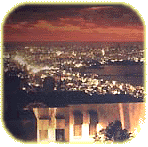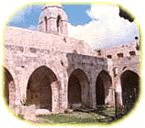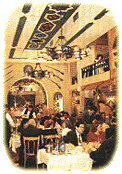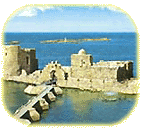 |
 |
 |
|
|||
|
Lebanon Revisited
During Lebanon's 15-year Civil war that ended in 1990, tens of thousands of cars were illegally imported into the country. This day, they all seem to be taking the Damascus road towards Baalbek. In another country, a driver might point out beautiful parks or monuments as points of interest. In Beirut all references hark back to the civil war. Driver Waiwadih Moussa explains. Moussa: This is the Green Line. The infamous Green Line divided Beirut into Christian and Moslem sections. In the no-man's land in the middle, every building was damaged or destroyed. Moussa says that's all being rebuilt now. Moussa: Yes. It's better than before. Everywhere in Lebanon, you can have a long, sad story, bad remembrance because of the war. Now we are seeing happy developments, a lot of infrastructure work. Indeed, that infrastructure is apparent once you drive out of greater Metropolitan Beirut. The road to Baalbek widens into a modern, 4-lane highway. It was originally built for the Syrian troops occupying the area. But you hardly notice the military these days -- except for the ten checkpoints on the road to Baalbek. The soldiers are mostly looking for stolen cars, though. So tourists usually have no problems -- as long as you come to a complete stop at each checkpoint. Once at the ruins a friendly guide makes me an offer I can't refuse.
RE: It's a money-back guarantee then? Khalil: Yes. RE: Has anyone ever not paid you? Khalil: No, never. After passing through an entrance gate, you suddenly see ancient walls and columns standing 10 stories high. The ruins are a true wonder of the world. You can see entire buildings just as the Romans built them, except for missing roofs. And visitors can actually touch walls built around 50 BC. The ruins were preserved over the centuries because of Baalbek's sunny, dry climate and total lack of pollution. The 3 temples are true architectural masterpieces. Our guide, Khalil, says the foundation of Jupiter's temple contains the largest pieces of rock ever used in construction, anywhere.
RE: How were they moved? Khalil: Thousands of slaves. Thousands of slaves built the temples over a period of 385 years and never finished. In ancient times, the Roman priests and aristocracy used the three temples for ceremonies -- and some pretty serious partying. They started with a few sacrifices in Jupiter's Temple, moved over the temple of Baachus -- the god of wine -- and then on to Venus, the temple of love. Khalil: Inside this temple they used to have Bacchanal parties. RE: Can you give me any details? Khalil: They drink wine, eat opium, make parties.
Baalbek was under the thumb of no less than five empires. And that troubled history continues down to recent times. From 1982-92 Baalbek was controlled by Iranian revolutionary guards and other strict adherents of Islam. So -- how can I phrase this -- tourism tapered off a lot. Even Lebanese couldn't go to the ruins. But the government has controlled the area for the past six years, and tourists are coming back. This year the Baalbek music festival has been revived. The Summer festival was once famous for classical and jazz concerts inside the acoustically unique temples. This year the Festival drew thousands of Lebanese to hear a variety of performers, including American Jazz greats Herbie Hancock and Betty Carter. Nicole Asseily, one of the festival organizers, says the Baalbek concerts symbolize the changes in today's Lebanon. Asseily: Due to the war, Baalbek was synonymous with narrow mindedness, extremism, violence, terror. Nobody dared go to Baalbek. It was a small island of something outside of this world. Now with the festival, it becomes something it has always been, a very beautiful place. Now it's synonymous with light, of music, beauty, open mindedness, openness to the world.
RE: Who are the best tippers? Khalil: The Americans, always. RE: Is that a hint? Khalil: [laughing] No! More Information: Americans can easily get to Beirut by flying to Paris, Frankfurt or other European capitals and then catching a connecting flight. The US State Department has issued an advisory against travel to Lebanon, but it is widely ignored by Lebanese Americans and by adventuresome travelers. Europeans regularly visit the country with no problems. You can obtain a tourist visa from the Lebanese embassy or consulates in the US, or buy one at the Beirut airport upon arrival. People are not allowed into Lebanon whose passport indicates that they visited Israel, even on a previous trip. (Americans who want to visit Israel can get a second passport from the State Department, or you can ask Israeli customs not to stamp your passport.)
|
 | American Public Media Home | Search | How to Listen ©2004 American Public Media | Terms of Use | Privacy Policy |

 To get to Baalbek, first I had to get out of Beirut. The problem isn't
Israeli dive bombers or hooded terrorists. It's the traffic.
To get to Baalbek, first I had to get out of Beirut. The problem isn't
Israeli dive bombers or hooded terrorists. It's the traffic.
 Khalil: My name is Khalil. I will be your guide. I will do my best to make
you enjoy the place. It's $14 charged by the Ministry. If you like it, you
pay. If you don't, you don't pay anything.
Khalil: My name is Khalil. I will be your guide. I will do my best to make
you enjoy the place. It's $14 charged by the Ministry. If you like it, you
pay. If you don't, you don't pay anything.
 The three biggest stones ever used in building -- 80 meters long, 4 meters
wide, 830 tons each block.
The three biggest stones ever used in building -- 80 meters long, 4 meters
wide, 830 tons each block.
 In later years Baalbek became an Arab fortress. In that spirit, visitors
can stop for some thick, Arabian coffee and listen to Bedouin folk music.
While the melody is played on an instrument that looks like a one-string
violin, the rhythm is made with a stick pounding inside an urn used to
grind coffee.
In later years Baalbek became an Arab fortress. In that spirit, visitors
can stop for some thick, Arabian coffee and listen to Bedouin folk music.
While the melody is played on an instrument that looks like a one-string
violin, the rhythm is made with a stick pounding inside an urn used to
grind coffee.
 Arab and European tourists have already rediscovered Baalbek. The Lebanese
hope to attract more Americans as well, despite the State Department
advisory against travel to Lebanon. For the moment, almost no tourists
visit Baalbek, something that displeases Khalil.
Arab and European tourists have already rediscovered Baalbek. The Lebanese
hope to attract more Americans as well, despite the State Department
advisory against travel to Lebanon. For the moment, almost no tourists
visit Baalbek, something that displeases Khalil.